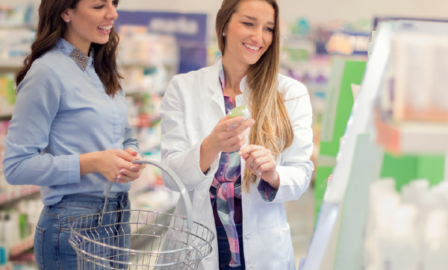5 Considerations for Designing an Inclusive Beauty Strategy in 2024
Beauty consumers are more aware than ever of their options for brand offerings. As such, the same marketing strategies that worked 10 or even five years ago will be ineffective today. This piece outlines five considerations for designing an inclusive beauty strategy in 2024.
It’s no secret that the beauty category is one of the fastest-growing industries, and consumer interests have evolved drastically in recent years. Rapidly changing trends, innovations, social factors, and information-sharing platforms have made the beauty industry one of the most lucrative business sectors for companies with the right insights and marketing strategy.
Consumers are also actively seeking brands that show commitment to authenticity and inclusivity and will back up these preferences with their wallets. According to cosmoprof’s trend forecasting for the next five years, the “one-size-fits-all approach” to beauty will gradually disappear in favor of hyper-personalization and true cultural understanding and appreciation. Future consumers will be increasingly inclusive and place value on what makes each person unique.
So, how can businesses break free from narrow representation and conventional beauty standards? In this piece, we’ll break down how companies are making beauty more accessible and inclusive by exploring non-traditional markets and underserved communities, providing a personalized and niche experience for the consumer.
Expand Your Consumer Base
Makeup brands have a massive consumer base, so tailoring to only a portion of their demographic is a missed opportunity. Appealing to a wider customer base has many benefits, including increasing brand recognition and customer loyalty. When customers see brands committed to addressing the needs of all consumers, they are more likely to support them, repurchase, and become repeat customers.
Companies that are early to this shift in the beauty industry will gain a competitive advantage and be able to earn customer loyalty when consumers find their unique needs being acknowledged and met. Fenty Beauty paved the way for inclusive marketing, with their campaign message of “Beauty for All” and the launch of 50 unique foundation shades, and other brands are following suit. Inclusive beauty goes beyond just shade ranges, however, thinking about it with a much more holistic and empowering approach to embrace our individual differences.
Beauty companies must go beyond simply using inclusive representation in their ad campaigns for marketing and media opportunities, but rather implement true inclusivity from formulation and packaging, to the availability of beauty options for every consumer’s unique needs, and even to the accessibility of purchasing platforms.
5 Considerations for Designing an Inclusive Beauty Strategy
1. A Renewed Focus on Transparency and Affordable Pricing
Over a quarter of consumers in the beauty space agree that affordable products are at the top of the list when it comes to what makes a brand inclusive. The average industry markups run anywhere from six to 10 times product costs. A few brands are making a name for themselves – due largely in part to accessible pricing strategies – and are quickly becoming Gen-Z favorites because of it, including The Ordinary and E.l.f., who clearly articulate the price breakdown for products, which sends a message of transparency and helps to build trust.
In addition to pricing transparency, consumers also want to see transparency from brands when it comes to the sustainability of ingredients, the carbon footprint of their shipping processes, and the payment conditions of people harvesting crops. Companies like Apottera Skincare are already embracing transparency practices to support this demand – the company developed a batch number system, allowing their customers to know about their product’s date of production, country of origin, ingredient certifications, and more.
One caveat for consideration: the use of “transparency” as a buzzword has the potential to become the newest form of greenwashing, as companies make ambiguous claims about being transparent on their packaging. Many have claims of “natural,” “clean,” or “green” products, with little to no information about the brand’s actual impacts and projects to mitigate those impacts. Companies need to implement a strategy to communicate authentic transparency in their business practices to earn consumers’ trust, rather than vague or indefinite claims.
2. Inclusive Shade Ranges No Longer a Nice-To-Have
Consumers are increasingly seeking inclusive beauty brands. This means formulating skincare and makeup products suitable for different skin types and tones, offering a wide range of shades, and developing haircare products that cater to diverse hair textures. Shoppers are more likely to purchase and repurchase products from brands that offer shades that cater to their skin tone and don’t make them feel excluded.
Companies that prioritize offering a shade range that caters to a wide variety of skin tones are demonstrating that the company values its customers and wants everyone to be able to find the perfect shade for their skin and beauty needs. This is critical in today’s world, where the beauty industry has a strong role to play in celebrating individuality and inclusivity. Brands can miss the opportunity to be more inclusive when they launch a large shade range but neglect to properly account for the wide variety of undertones that are needed for complexion products. The lack of dark or light enough shades with the right undertones for every consumer to find their perfect match pushes people to choose formulas that may not fit their preferences for coverage, finish, ingredient lists, or price range.
3. Gender-Fluid Makeup Lines
Younger generations reject the notion that beauty is a female-only pursuit and prefer cosmetics and skincare products to be viewed as a universal form of self-care and expression. Today, the beauty industry has faded out specific roles of genders. “For her” or “for him” marketing tactics that were used in the past have been replaced as people are calling for more gender-neutral products that focus on the function of the product itself. Gender-fluid makeup lines and brands that are encouraging men to wholly embrace personal care are becoming more influential.
We will see this shift more and more as brands like Morphe and Milk Makeup are increasingly adopting an open, gender-neutral approach to their marketing and packaging to appeal to a widening range of buyers.
4. Rejecting the “Anti-Aging” Narrative
Ad campaigns and launches are typically targeted at a younger audience, claiming to “fix” signs of aging. However, in the current state of beauty, consumers are increasingly expecting brands to change the narrative and destigmatize ‘flaws.’ There is a transition to become more inclusive and move from “anti-aging” to “age well” products that embrace the different stages of life as beautiful in their own right. In fact, in 2017 Allure resolved to stop using the term “anti-aging” altogether. Further, younger age groups are looking for preventative rather than reactive “well–aging” products, and other beauty companies are catering to aging adults by making their product packaging and design easier to use, with larger fonts, pumps, and ridged tops.
According to a study done by AARP, women over 50 feel overlooked by the beauty industry despite spending a whopping $22 billion on beauty products annually. Beauty companies should capitalize on this opportunity to create inclusive marketing strategies to reach this older demographic and broaden their market reach by using terminology like “age-well,” making easy-to–use packaging, and representing older models as spokespeople or in ad campaigns.
5. Accessibility Top of Mind
Industry giants like L’Oréal, Estée Lauder, and Unilever are hoping to improve the accessibility of their products for all people with universal design, accessible websites, and listening to the voices of folks with disabilities. Some companies have taken the first step by implementing easy-to-open, easy-to-use packaging or braille lettering on the outside of beauty packaging.
Companies should prioritize online shopping accessibility for this demographic, making their eCommerce platforms more user-friendly for people with disabilities. Individuals with disabilities make up an enormous and powerful economic group that represents about 10% of total online spending. But for folks with disabilities to take full advantage of online shopping, they need the right tools and resources on a brand’s website – this can include alternative text for the blind or visually impaired using screen readers, accurate form labels that are available to assistive technology, and being no-mouse friendly.
Beauty companies that don’t create accessible beauty products and eCommerce platforms are missing out on the opportunity to reach all of their potential customers as well as improve the customer experience, and in turn, customer loyalty. Ensuring greater accessibility for all customers isn’t just the right thing to do, it’s good for business and shows your commitment to diversity and inclusion through an enhanced customer experience.
Looking Ahead
Consumers will be increasingly aware of brands’ commitments to inclusive beauty initiatives in the coming years, as beauty moves away from its narrow representation and lack of inclusivity. Authenticity is crucial as consumers look for brands that deliver on their promised values and play a meaningful role in society. It will be critical for companies to back up their claims with action. The steps toward more inclusive shade ranges, gender inclusivity, age positivity, and increased accessibility for consumers with disabilities are trends that will continue to grow in the beauty industry in years to come and are critical considerations for your inclusive marketing strategy.
For more information on inclusive marketing trends and strategy, talk to the experts at Clarkston Consulting.
Subscribe to Clarkston's Insights
Contributions by Julia Hoffman




